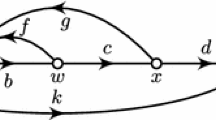Abstract
This research presents a discrete-time transmission line model based on the propagation of travelling waves. In this approach, the transmission line is emulated by means of many interconnected unit delay cells implemented with switched-capacitor (SC) circuits. The accuracy and limitations of this method is compared to existing transconductance–capacitor solutions and is evaluated in the frame of a novel power network fault location method based on the electromagnetic time-reversal principle. The impact of the non-ideal effects associated to analog CMOS SC circuits, such as amplifier finite gain, offset and switch charge injection is evaluated in the same context. A possible application of the model for the simulation of interconnected or multi-conductor lines is also discussed. After an AMS 0.35 µm process implementation, it is shown that the present method allows a fault location within 1% resolution and is a hundred times faster than nowadays digital solutions. This speed improvement allows a fault location within 160 ms, making thus real-time applications realistic.










Similar content being viewed by others
References
Razzaghi, R., Lugrin, G., Manesh, H., Romero, C., Paolone, M., & Rachidi, F. (2013). An efficient method based on the electromagnetic time reversal to locate faults in power networks. IEEE Transactions on Power Delivery, 28(3), 1663–1673.
Razzaghi, R. (2016). Fast simulation of electromagnetic transients in power systems: Numerical solvers and their coupling with the electromagnetic time reversal process. Ph.D. Dissertation, EPFL, Lausanne, Switzerland, Thesis No. 6903.
Fink, M. (1992). Time reversal of ultrasonic fields. I. Basic principles. IEEE Transactions on Ultrasonics, Ferroelectrics and Frequency Control, 39(5), 555–566.
Wu, F., Thomas, J.-L., & Fink, M. (1992). Time reversal of ultrasonic fields. II: Experimental results. IEEE Transactions on Ultrasonics, Ferroelectrics and Frequency Control, 39(5), 567578.
Cassereau, D., & Fink, M. (1992). Time-reversal of ultrasonic fields. III. Theory of the closed time-reversal cavity. IEEE Transactions on Ultrasonics, Ferroelectrics and Frequency Control, 39(5), 579592.
Gaugaz, F., Krummenacher, F., & Kayal, M. (2015). High-speed analog processing for real-time fault location in electrical power networks. In IEEE NEWCAS.
Gaugaz, F., Krummenacher, F., & Kayal, M. (2016). OTA-C based high-speed analog processing for real-time fault location in electrical power networks. Springer Analog Integrated Circuits and Signal Processing, 89(1), 61–67.
Gaugaz, F., Krummenacher, F., & Kayal, M. (2016). Implementation guidelines for a real-time fault location system in electrical power networks. In IEEE BEC.
Gaugaz, F., Krummenacher, F., & Kayal, M. (2017). Implementation of a high-speed discrete-time analog emulator for real-time fault location in electrical power networks. In IEEE NEWCAS.
Gaugaz, F. (2017). Electronics emulation for real-time fault location in power systems. Ph.D. Dissertation, EPFL, Lausanne, Switzerland, Thesis No. 7757.
Ramo, S., Whinnery, J. R., & van Duzer, T. (1994). Fields and waves in communication electronics (3rd ed.). New York: Wiley.
Salimi, K., Krummenacher, F., Dehollain, C., & Declercq, M. (2002). Continous-time CMOS circuits based on multi-tanh linearisation principle. Electronics Letters, 38(3), 103–104.
Yen, R., & Gray, P. (1988). A MOS switched-capacitor instrumentation amplifier. IEEE Journal of Solid-State Circuits, 17(6), 1008–1013.
McCharles, R., & Hodges, D. (1978). Charge circuits for analog LSI. IEEE Transactions on Circuits and Systems, 25(7), 490–497.
Wedepohl, L. M. (1963). Application of matrix methods to the solution of travelling-wave phenomena in polyphase systems. Proceedings of IEEE, 110(12), 2200–2212.
Hedman, D. E. (1965). Propagation on overhead transmission lines I-Theory of modal analysis. IEEE Transactions on Power Apparatus and Systems, 84(3), 200–205.
Author information
Authors and Affiliations
Corresponding author
Additional information
This research has been Funded by the Swiss National Science Foundation (SNSF), within the Project N: 146414.
Rights and permissions
About this article
Cite this article
Gaugaz, F., Krummenacher, F. & Kayal, M. Switched-capacitor high-speed emulator for real-time fault location in electrical power systems. Analog Integr Circ Sig Process 97, 449–456 (2018). https://doi.org/10.1007/s10470-018-1226-1
Received:
Revised:
Accepted:
Published:
Issue Date:
DOI: https://doi.org/10.1007/s10470-018-1226-1




